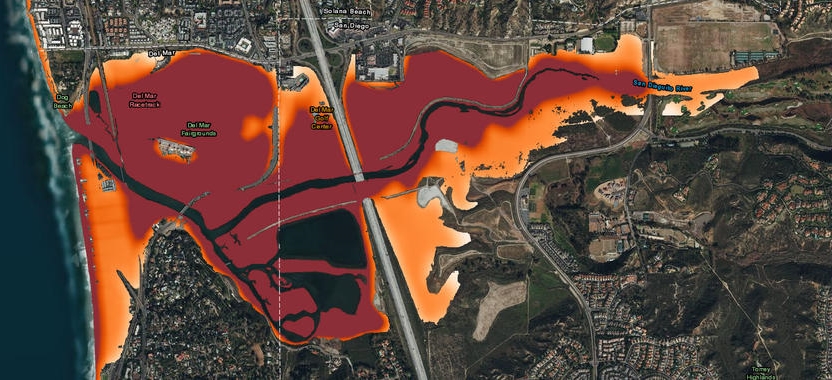Destruction from sea level rise in California could exceed worst wildfires and earthquakes – “These are significant events that are going to recur and be ten times the scale of the worst wildfires and earthquakes that we’ve experienced in modern California history”

By Rosanna Xia
13 March 2019
(Los Angeles Times) – In the most extensive study to date on sea level rise in California, researchers say damage by the end of the century could be far more devastating than the worst earthquakes and wildfires in state history.
A team of U.S. Geological Survey scientists concluded that even a modest amount of sea level rise — often dismissed as a creeping, slow-moving disaster — could overwhelm communities when a storm hits at the same time.
The study combines sea level rise and storms for the first time, as well as wave action, cliff erosion, beach loss and other coastal threats across California. These factors have been studied extensively but rarely together in the same model.
The results are sobering. More than half a million Californians and $150 billion in property are at risk of flooding along the coast by 2100 — equivalent to 6% of the state’s GDP, the study found, and on par with Hurricane Katrina and some of the world’s costliest disasters. The number of people exposed is three times greater than previous models that considered only sea level rise.
And at a time when marshes are drowning, cliffs eroding, beaches disappearing and severe storms likely to become more frequent, scientists say even a small shift in sea level rise could launch a new range of extremes that Californians would have to confront every single year.
“It’s not just some nuisance that’s going to pop its head up once in a while,” said Patrick Barnard, research director of the USGS Climate Impacts and Coastal Processes Team and lead author of the study. “These are significant events that are going to recur and be ten times the scale of the worst wildfires and earthquakes that we’ve experienced in modern California history.” [more]

ABSTRACT: Coastal inundation due to sea level rise (SLR) is projected to displace hundreds of millions of people worldwide over the next century, creating significant economic, humanitarian, and national-security challenges. However, the majority of previous efforts to characterize potential coastal impacts of climate change have focused primarily on long-term SLR with a static tide level, and have not comprehensively accounted for dynamic physical drivers such as tidal non-linearity, storms, short-term climate variability, erosion response and consequent flooding responses. Here we present a dynamic modeling approach that estimates climate-driven changes in flood-hazard exposure by integrating the effects of SLR, tides, waves, storms, and coastal change (i.e. beach erosion and cliff retreat). We show that for California, USA, the world’s 5th largest economy, over $150 billion of property equating to more than 6% of the state’s GDP and 600,000 people could be impacted by dynamic flooding by 2100; a three-fold increase in exposed population than if only SLR and a static coastline are considered. The potential for underestimating societal exposure to coastal flooding is greater for smaller SLR scenarios, up to a seven-fold increase in exposed population and economic interests when considering storm conditions in addition to SLR. These results highlight the importance of including climate-change driven dynamic coastal processes and impacts in both short-term hazard mitigation and long-term adaptation planning.
Dynamic flood modeling essential to assess the coastal impacts of climate change